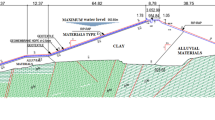Conclusions
-
1.
The use of a combined approach based on the solution of two- and three-dimensional problems of the stress-strain state made it possible to analyze the serviceability of a high dam composed of gravel and stone with a reinforced-concrete facing under three-dimensional conditions with a site coefficient 2.
-
2.
The absolute values of the dimensions of the structure and site rather than their relationship (site coefficient, etc.) affect the development of the arching effect in the dam, i.e., the smaller the distance between the canyon walls (or relatively more rigid elements in the dam), the more the arching effect is displayed.
-
3.
For a preliminary estimate of the values of the vertical stresses under three-dimensional conditions it is possible to use conversion on the basis of the results of solving two two-dimensional problems for characteristic section of the dam. A similar conversion for other stress components does not have sufficient grounds.
-
4.
With respect to design, i.e., when estimating the serviceability on the basis of the profile, a dam with a compressed profile made of gravel and stone with a reinforced-concrete facing with a height of 335 m is quite deformable and unstable, especially in the case of a decrease of the quality of placing the soils. However, due to the three-dimensionality of the work of the structure its deformations decrease by at least twofold and stability increases by 1.5 times.
-
5.
Curves with minimum values of the weighted average safety facor in the case of a high stability of the dam are not the “curves of sliding failure,” since they bound practically symmetric “slices of failure.” But with development of the zones of the limit state of the soil and decrease of stability of the structure these curves are transformed, acquiring a form comparable with cylindrical (or other) surfaces of failure.
-
6.
A decrease of the scale of the linear dimensions of a dam with a reinforced-concrete facing by half substantially decreases its deformations and increases the stability. Consequently, to ensure a high reliability of structures of such type they must be constructed with a height of not more than 180–200 m. On the other hand, the desirability of regular inspection of the facing, especially in the first years of operation of the dam, limits the area of use of such dams to seasonal reservoirs.
Similar content being viewed by others
Literature cited
S. N. Moiseev and I. S. Moissev, Earth-Rock Dams [in Russian], Énergiya, Moscow (1977).
C. L. Comte, “Etanchement du parement amont de la digue en enrochement de Paradela (Portugal),” Colloque “Etancheite superficielle,” Paris (1983), pp. 165–170.
L. N. Rasskazov and A. A. Belyakov, “Stability of a gravel dam with a grout core,” Gidrotekh. Stroit., No. 5 (1984).
L. N. Rasskazov, “Scheme of construction and stress-stress state of an earth dam with a central core,” Energ. Stroit., No. 2 (1977).
L. N. Rasskazov and A. A. Belyakov, “Calculation of the three-dimensional stress-strain state of an earth-rock dam,” Gidrotekh. Stroit., No. 2 (1982).
Yu. I. Svateev, “Use of the results of solving two-dimensional problems by estimating the three-dimensional stress state of an earth-rock dam with a core,” Tr. VODGEO, No. 34 (1972).
L. N. Rasskazov, “Yield condition of soils,” Tr. VODGEO, No. 14 (1974).
Additional information
Translated from Gidrotekhnicheskoe Stroitel'stvo, No. 8, pp. 19–25, August, 1985.
Rights and permissions
About this article
Cite this article
Belyakov, A.A. Serviceability of an earth dam with a reinforced-concrete facing. Hydrotechnical Construction 19, 404–414 (1985). https://doi.org/10.1007/BF01439554
Issue Date:
DOI: https://doi.org/10.1007/BF01439554




